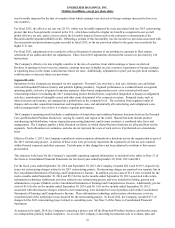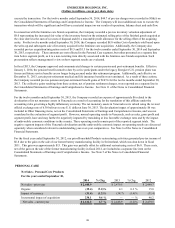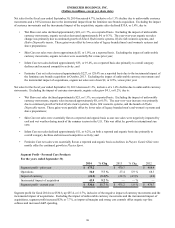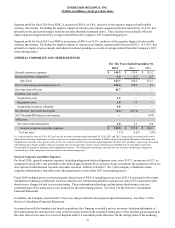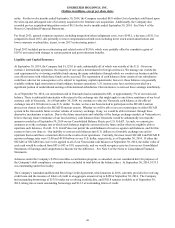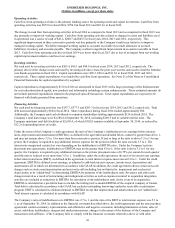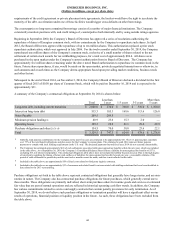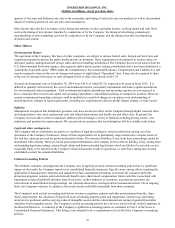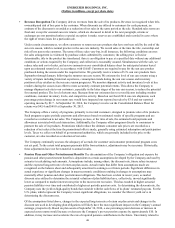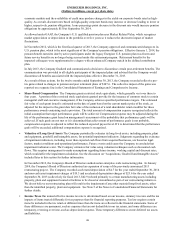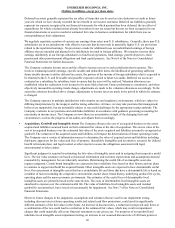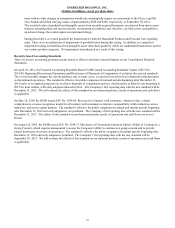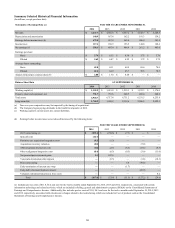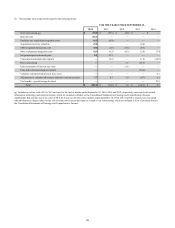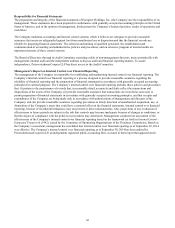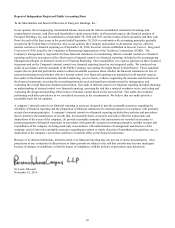Energizer 2014 Annual Report Download - page 49
Download and view the complete annual report
Please find page 49 of the 2014 Energizer annual report below. You can navigate through the pages in the report by either clicking on the pages listed below, or by using the keyword search tool below to find specific information within the annual report.
ENERGIZER HOLDINGS, INC.
(Dollars in millions, except per share data)
Market Risk Sensitive Instruments and Positions
The market risk inherent in the Company’s financial instruments and positions represents the potential loss arising from adverse
changes in currency rates, commodity prices, interest rates and the Company’s stock price. The following risk management
discussion and the estimated amounts generated from the sensitivity analysis are forward-looking statements of market risk
assuming certain adverse market conditions occur. Company policy allows derivatives to be used only for identifiable
exposures and, therefore, the Company does not enter into hedges for trading purposes where the sole objective is to generate
profits.
Currency Rate Exposure
Derivatives Designated as Cash Flow Hedging Relationships
A significant share of the Company’s sales are tied to currencies other than the U.S. dollar, the Company’s reporting currency.
As such, a weakening of currencies relative to the U.S. dollar can have a negative impact to reported earnings. Conversely,
strengthening of currencies relative to the U.S. dollar can improve reported results. The primary currencies to which the
Company is exposed include the Euro, the Japanese Yen, the British pound, the Canadian dollar and the Australian dollar.
The Company enters into a series of forward currency contracts to hedge the cash flow uncertainty of forecasted inventory
purchases due to currency fluctuations. These transactions are accounted for as cash flow hedges. The Company had an
unrealized pre-tax gain of $14.5 and $1.5 at September 30, 2014 and September 30, 2013, respectively, on these forward
currency contracts accounted for as cash flow hedges included in Accumulated other comprehensive loss on the Consolidated
Balance Sheets. Assuming foreign exchange rates versus the U.S. dollar remain at September 30, 2014 levels over the next
twelve months, approximately $13.7 of the pre-tax gain included in Accumulated other comprehensive loss at September 30,
2014, is expected to be included in earnings. Contract maturities for these hedges extend into fiscal year 2016. There were 79
open foreign currency contracts at September 30, 2014 with a total notional value of approximately $316.
Derivatives Not Designated as Cash Flow Hedging Relationships
The Company’s foreign subsidiaries enter into internal and external transactions that create non-functional currency balance
sheet positions at the foreign subsidiary level. These exposures are generally the result of intercompany purchases,
intercompany loans and to a lesser extent, external purchases, and are revalued in the foreign subsidiary’s local currency at the
end of each period. Revaluation of the non-functional currency balance sheet positions against the foreign subsidiary’s
functional currency results in an exchange gain or loss recorded in Other financing items, net on the Consolidated Statements of
Earnings and Comprehensive Income. The primary currency to which the Company’s foreign subsidiaries are exposed is the
U.S. dollar.
The Company enters into foreign currency derivative contracts which are not designated as cash flow hedges for accounting
purposes to hedge these balance sheet exposures. Any gains or losses on these contracts are expected to be offset by a
transaction gains or losses on the underlying exposures, thus they are not subject to significant market risk. The change in
estimated fair value of the foreign currency contracts resulted in income of $4.2 and $4.9 for the twelve months ended
September 30, 2014 and 2013, respectively, and was recorded in Other financing items, net on the Consolidated Statements of
Earnings and Comprehensive Income. There were 13 open foreign currency derivative contracts which are not designated as
cash flow hedges at September 30, 2014, with a total notional value of approximately $270.
Venezuela Currency Risk
The Company has investments in Venezuelan affiliates. Venezuela has been considered highly inflationary under GAAP since
January 1, 2010. In addition, the conversion of local monetary assets to U.S. dollars is restricted by the Venezuelan
government. In February 2013, the Venezuelan government devalued its local currency in relation to the U.S. dollar from 4.30
per U.S. dollar to 6.30 per U.S. dollar. In addition, the Central Government also suspended the alternate currency market
administered by the central bank known as SITME that made U.S. dollars available at a rate higher than the previous official
rate, generally in the range of 5.50 per U.S. dollar. The Company had been utilizing SITME to obtain U.S. dollars for the
import of product on a regular basis since the establishment of this market, as access to U.S. dollars at the official exchange rate
was greatly limited. On January 24, 2014, the Venezuelan government issued Exchange Agreement No. 25, which stated the
rate of exchange established in the most recent SICAD I auction will be used for payments related to international investments,
royalties and the use and exploitation of patents, trademarks, licenses, franchises and technology. On March 10, 2014, the
Venezuelan government announced the inception of the SICAD II program as an additional mechanism to purchase foreign
45




